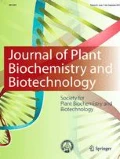Abstract
In vitro assay for cytotoxic activity of glands/hairs obtained from the fruits of Mallotus philippinensis has been carried out against 14 human cancer cell lines from nine different origins via 95% ethanolic, 50% ethanolic and aqueous extract at the concentration of 100 μg/ml. Results revealed that the 95% ethanolic extract showed highest in vitro cytotoxic effect against all the 14 human cancer cell lines. The fractions of the same extract i.e. 95% ethanolic were obtained and it was found that the significant cytotoxic potential was produced by the chloroform soluble fraction at 100 μg/ml as this fraction inhibited the growth of ten human cancer cell lines from seven different tissues. Further, the chromatographic analysis of the said fraction afforded a polyphenolic molecule rottlerin. This drug at the concentration of 1 × 10−5M and 1 × 10−4M suppressed the proliferation of eight human cancer cell lines from six different tissues and proved its exceptionally remarkable in vitro anticancer efficiency.

Similar content being viewed by others
Abbreviations
- DMEM:
-
Dulbecco’s minimum essential medium
- NCCS:
-
National Centre for Cell Science
- NCI:
-
National Cancer Institute
- PBS:
-
Phosphate buffer saline
- RPMI:
-
Rosewell Park Memorial Institute
- SRB:
-
Sulphorhodamine blue
- TLC:
-
Thin layer chromatography
References
Ahluwalia VK, Sharma ND, Mittal B (Late), Gupta SR (1988) Novel prenylated flavanoids from Mallotus philippinensis Muell. Arg Ind J Chem 22B: 238–241
Anderson A (1885) Kamala resin – rottlerin. Edin New Phil Journ 1:296–300
Chan FL, Choi HL, Chen ZY, Chan PS, Huang Y (2000) Induction of apoptosis in prostate cancer cell lines by a flavonoid. Cancer Lett 160:219–228
Gresshoff M (1898) Tweete vervolg van het Onderzoek naar de Plantenstoffen van Nederlandsch Indie. Batavia gr 8 Cart M 6: 173–176
Gupta SC, Sharma VN, Agarwaal JS (1952) Chemical constitution of the seeds of Mallotus philippinensis. Jour Sci Ind Res 11B:463–468
Gujral ML, Varma DR, Sareen KN (1960a) Oral contraceptives (PartI) Antifertility effect of Mallotus philippinensis. Ind Jour Med Res 48:46–51
Gujral ML, Varma DR, Sareen KN, Roy AK (1960b) Oral contraceptives (PartII) antifertility effect of Mallotus philippinensis. Ind Jour Med Res 48:52–58
Hirano T, Gotoh M, Oka K (1994) Natural flavonoids and lignans are potent cytostatic agents against human leukemic HL-60 cells. Life Sci 55:1061–1069
Khorana ML, Motiwala DK (1949) Anthelmintic activity of Kamala and its constituents. Ind Jour Pharm 11:37–43
Monks A, Scudiero D, Skehan P, Shoemaker R, Paull K, Vistica D, Hose C, Langley J, Cronisc T, Vaigro-Wolff A, Gray-Goodrich M, Campbell H, Maya J, Boyd M (1991) Feasibility of a high—flux anticancer drug screen using a diverse panel of cultured human tumor cell lines. J Natl Cancer Inst 83:757–766
Nagamachi A (1921) Uber die pharmakologisch Wirkung des Rottlerins des Hauptbestandteils der Kamala: Acta scholae med univ imp. Bioto 4:307–317
Perkin AG, Perkin WH (1886) Notiz iiber kamala – Mallotoxin. Ber 19:3109–3110
Robertson A (1937) Rottlerin Part I. Jour Chem Soc 1:748–750
Sasidharan N (1987) Forest trees of Kerala. Forest Research Institute, Peechi
Satyavati GV, Gupta KAA, Tandon N (eds.) (1987) Medicinal plants of India, ICMR 2: 201–210
Skehan P, Storeng R, Scudiero D, Monks A, McMohan J, Vistica D, Warren JT, Bokesh H, Kenny S, Boyd M (1990) New colorimetric cytotoxcity assay for anticancer drug screening. J Natl Cancer Inst 82:1107–1112
Tanaka T, Ito T, Iinuma M, Takahashi Y, Naganawa H (1998) Dimeric chalcone derivatives from Mallotus philippinensis. Phytochemistry 48:1423–1427
The Wealth of India (1962) Dictionary of Indian Raw Materials and Industrial Products CSIR: New Delhi 5: 229–240
Widen CJ, Puri HS (1980) Natural occurance and chemical variability of phloroglucinols in Kamala. Planta Medica 40:284–287
Acknowledgments
The author is thankful to Indian Institute of Integrative Medicine (CSIR), Jammu for providing technical support.
Author information
Authors and Affiliations
Corresponding author
Rights and permissions
About this article
Cite this article
Sharma, V. A polyphenolic compound rottlerin demonstrates significant in vitro cytotoxicity against human cancer cell lines: isolation and characterization from the fruits of Mallotus philippinensis . J. Plant Biochem. Biotechnol. 20, 190–195 (2011). https://doi.org/10.1007/s13562-011-0045-6
Received:
Accepted:
Published:
Issue Date:
DOI: https://doi.org/10.1007/s13562-011-0045-6



